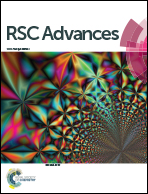Progress of 3-aminopyridinium-based synthetic receptors in anion recognition
Abstract
This review describes the overall development on synthetic receptors built on the pyridinium motif with different functionalities at the 3-position in anion recognition. The review covers only the organic systems. In the designs, the pyridinium group along with the other functional motifs plays a crucial role in the binding of various anions of different shapes and sizes. Complexation characteristics are communicated through changes in 1H NMR, emission, color or gelation behaviours.


 Please wait while we load your content...
Please wait while we load your content...